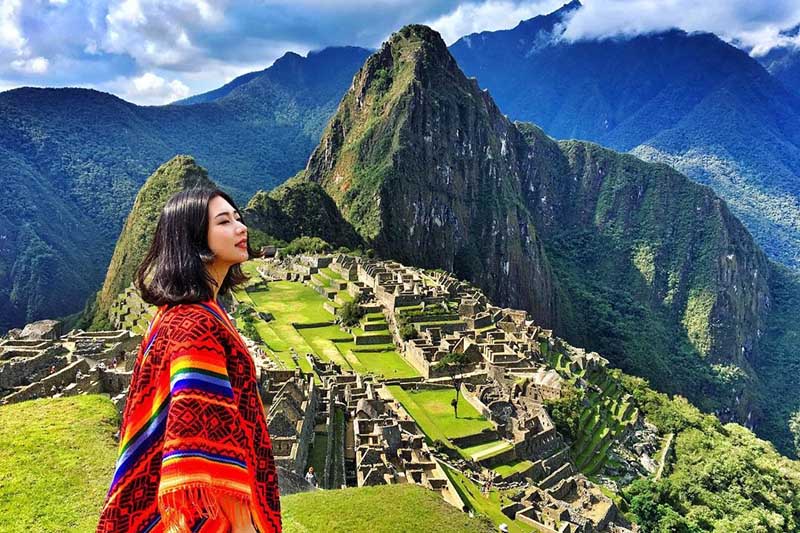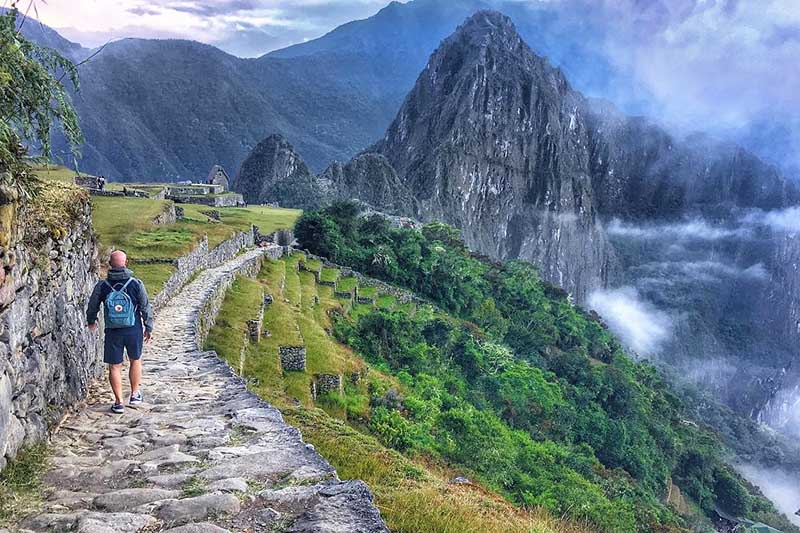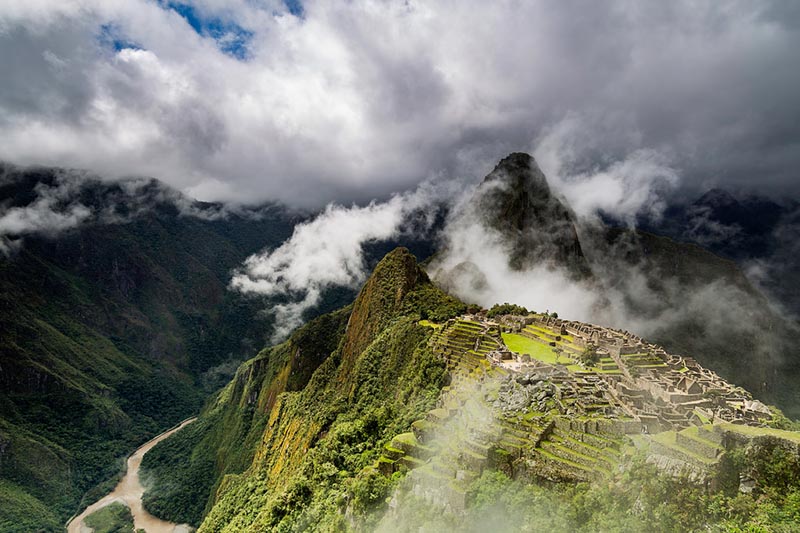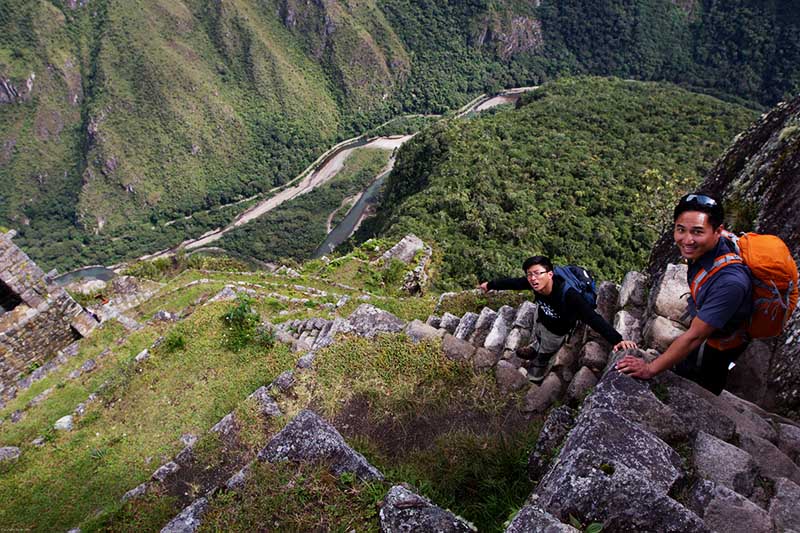8 myths and truths about the trip to Machu Picchu
Was it discovered by Hiram Bingham? Did the Spanish conquerors not know of their existence? Isn’t it possible to visit it during the rainy season? Can you only access the Inca City via the difficult Inca Trail? If you’re about to travel to Machu Picchu, clear your doubts. These are the myths and truths that you should know about the Maravilla del Mundo.
- Was it discovered by Hiram Bingham?
- Did the Spanish conquerors not know of their existence?
- Can you only access the Inca city via the Inca Trail?
- Is climbing from Aguas Calientes to Machu Picchu impossible?
- Isn’t it possible to visit it during the rainy season?
- Is chewing a coke a drug?
- Is it dangerous to climb the Huayna Picchu mountain?
- Does altitude sickness really exist?

These are some of the myths and truths about the trip to the Inca city of Machu Picchu
Should I really buy the entrance to Machu Picchu online?
Today, Machu Picchu is considered one of the ‘Siete Maravillas del Mundo’. The inca city ticket must be reserved in advance due to its high demand. Otherwise, there is a risk of not finding availability. If there are some tickets on sale in the town of Aguas Calientes (one thousand tickets), the safest option is always to make the purchase online.
Was it discovered by Hiram Bingham?
- The most correct thing to say is that Machu Picchu was never discovered. The people close to the place know its existence.
- It was the American explorer Hiram Bingham, the man who revealed to the world the existence of the Inca City of Machu Picchu on a trip in 1911.
- However, according to Cusqueño writer Américo Rivas (author of the book ‘Agustín Lizárraga, the great discoverer of Machu Picchu’), new years before the arrival of the North American, the Peruvian farmer Lizárraga explored the place and highlighted to his knowledge the importance of the archaeological remains of the city.
Did the Spanish conquerors not know of their existence?
- Myth. The Spanish conquerors knew the existence of the Inca city.
- According to the investigations of doctor John Rowe, behind the conquest of Spanish people in Peru, Hernando Pizarro, received an encomienda (group of indigenous people who were forced to pay tribute) that included the inhabitants of this place.
- There are even remains of a fire in the Temple of the Sun in Machu Picchu. This fire occurred during a Spanish visit to the Inca city in the sixteenth century.
- However, due to its reduced population, it is not enjoying protagonism in the Virreinato. This is how Machu Picchu was gradually abandoned until its total abandonment.
Can you only access Ciudadela Inca via the Camino Inca?
- False. While the Inca Trail was once the Tahuantinsuyo was the main route to Machu Picchu, it changed with modernity.
- Today, there are many roads to get to Ciudadela Inca. The main one is via a train that follows the route of the Vilcanota river to go up a mountain (by bus or on foot).
- However, the Inca Trail continues to be an option. There are two routes: the 4-day Classic Inca Trail or the 2-day Short Inca Trail. Both allow you to appreciate Machu Picchu for the first time from the Intipunku (Puerta del Sol), just like the Incas did.
- Furthermore, there is another way to reach Machu Picchu. It is a 5-hour Hidroeléctrica route from the city of Cusco. The last section is on foot for 10 kilometers (2 hours) to the town of Aguas Calientes.
- Other hiking routes lasting several days use this Hidroeléctrica route to reach Machu Picchu. These routes are: the Salkantay trek or the Inca Jungle.

View of Macchu Picchu as you enter via the Inca trail
Is climbing from Aguas Calientes to Machu Picchu impossible?
- Myth. There are two options to get to Machu Picchu before arriving at the town of Aguas Calientes. The first is a walk down a slope that takes approximately 2 hours. Otherwise, take a bus that takes 30 minutes to take you to Ciudadela Inca.
- Most visitors prefer to take the bus where the section is ascending (10 kilometers approximately). However, many tourists, especially young ones, like to go hiking.
- The footpath is carried out ascending stone steps that climb up to Machu Picchu. The walk takes 2 hours or a little longer, depending on the physical condition of the visitor. It’s free for everyone.
Isn’t it possible to visit it during the rainy season?
- Myth. During the rainy season (from November to March) you can also visit the Inca City of Machu Picchu.
- If there is not as much tourist competition as in the dry season (from April to October), you can still enjoy this destination.
- The rains can bother the visitor. I’m especially for tourists who want to get the classic postcard photo in Machu Picchu. When the fog hits, it can prevent you from getting that dream photo.
- It is recommended to bring a poncho for rain. During the rainy season, when it’s rainy, you can take beautiful photos of Machu Picchu with imposing greenery.
- The rains do not occur throughout the day and prices can be more economical. In fever, the Inca Trail remains closed for maintenance so it can only be reached by train.

Machu Picchu in the rainy season
Is chewing a coke a drug?
- False. The coca leaf is a natural medicinal herb originating from the Amazon Andes. Its role in Incanato was of great value as a natural energy plant.
- Today, the inhabitants of the Andes use this today to help reduce the sensation of hambre and physical exertion. On the Inca Trail, chewing coca leaves is highly recommended.
- Unfortunately, the coca leaf is the base product for the manufacture of cocaine. However, chewing the coke does not have any restrictions in Peru.
Is it dangerous to climb the Huayna Picchu mountain?
- Myth. Climbing and descending the mountain of Huayna Picchu is not dangerous, it is exhausting. The climb can lead to sensations of vertigo in the visitor.
- However, if you follow the safety measures there is no risk. There is a significant demand for tickets so tickets must be purchased at least two months in advance.
- A few years ago it was allowed to visit the Temple of the Moon on the slopes of the Huayna Picchu mountain. Today this route is closed to the public due to safety concerns.
- Entrance to the Huayna Picchu mountain is only permitted for visitors over 12 years old.

Tourists descending from the Huayna Picchu mountain
The mountain Machu Picchu
Beyond the Huayna Picchu mountain there is another hiking trail in the Inca city. This is the route to the Machu Picchu mountain. This is wider than Huayna Picchu, but with fewer dimensions. Furthermore, there is a route to the Huchuy Picchu mountain. This summit is just a slope of Huayna Picchu because the hike is simple and suitable for everyone. All the hikes offer beautiful landscapes of the Inca city.
Does altitude sickness really exist?
- True. Altitude sickness or ‘soroche’ is not a myth and its symptoms can be felt mainly in the city of Cusco (3,399 m above sea level).
- Symptoms of altitude sickness can occur in geographies that exceed 2,400 m above sea level.
- Altitude sickness is caused by the organism’s poor adaptation to the low oxygen pressure of places at high altitudes. Symptoms generally consist of: nausea, vomiting, agitation, physical exhaustion, headache and others.
- In general, medical attention is not necessary, but rest. The most complicated cases heal within days or weeks until the body gets used to the Andean climate. It is recommended to drink coca mate to combat altitude sickness.
- Symptoms can be more intense when visiting high-altitude tourist destinations such as the Humantay Lagoon (4,200 m above sea level) or Vinicunca (5,200 m above sea level).
- In any case, it is recommended to spend one day adapting to the Andean geography of Cusco before visiting the highly geographical tourist attractions. This way the tourist will be better adapted to the Andes Mountains and the symptoms of altitude sickness will be minimal.
- Machu Picchu is located at 2,430 meters above sea level, so the symptoms of altitude sickness are minimal.
Advice from people who have been there
 By: Kike P.
By: Kike P.“Majestic, beautiful, immense!“
“We went as a family to spend 5 days in Cusco and decided that going to Machu Picchu was an unmissable destination. Even though it involves getting up early, the experience is wonderful. First we took a bus to Ollantaytambo, then we took one of the most beautiful trains in the world. On the ground for the landscapes, I bell for the attention of Peruvians. The train took us to Aguas Calientes, from where we then took a bus to go up to the Sanctuary, which is immense, beautiful, majestic“
By Ticket Machu Picchu – Last updated, August 15, 2024